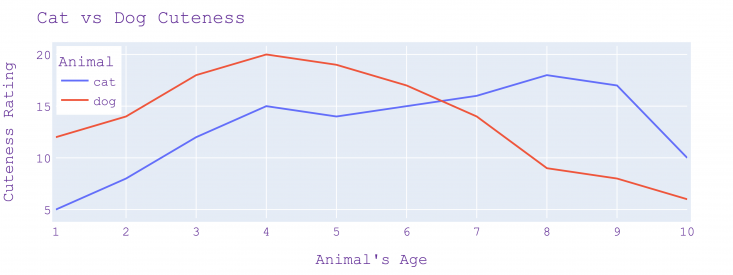You are viewing an old version of this page. Return to the latest version.
Difference between revisions of "Fancy Plots using Plotly"
m (Syntax test) (Tag: Visual edit) |
m (Space syntax test) (Tag: Visual edit) |
||
| Line 100: | Line 100: | ||
else: | else: | ||
fig.write_image(FIG_DIR + "/" + PLOT_NAME + "." + PLOT_TYPES[i], scale=5) | fig.write_image(FIG_DIR + "/" + PLOT_NAME + "." + PLOT_TYPES[i], scale=5) | ||
| − | </syntaxhighlight><syntaxhighlight lang="python" line="1"> | + | </syntaxhighlight> |
| + | <br /><syntaxhighlight lang="python" line="1"> | ||
import plotly.express as px | import plotly.express as px | ||
import pandas as pd | import pandas as pd | ||
| Line 114: | Line 115: | ||
PLOT_WIDTH = 800 | PLOT_WIDTH = 800 | ||
PLOT_HEIGHT = 300 | PLOT_HEIGHT = 300 | ||
| + | |||
df = pd.read_csv('./data/sample.csv') | df = pd.read_csv('./data/sample.csv') | ||
fig = px.line(df, x="age", y="cuteness", color="animal") | fig = px.line(df, x="age", y="cuteness", color="animal") | ||
fig.update_layout( | fig.update_layout( | ||
| − | + | title="Cat vs Dog Cuteness", | |
| − | + | xaxis_title="Animal's Age", | |
| − | + | yaxis_title="Cuteness Rating", | |
| − | + | legend_title="Animal", | |
| − | + | font=dict( | |
| − | + | family="Courier New, monospace", | |
| − | + | size=14, | |
| − | + | color="RebeccaPurple" | |
| − | + | ) | |
) | ) | ||
fig.update_layout( | fig.update_layout( | ||
| − | + | autosize=True, | |
| − | + | width=PLOT_WIDTH, | |
| − | + | height=PLOT_HEIGHT, | |
| − | + | margin=dict( | |
| − | + | l=50, | |
| − | + | r=50, | |
| − | + | b=50, | |
| − | + | t=50, | |
| − | + | pad=4 | |
| − | + | ), | |
| − | + | legend=dict( | |
| − | + | yanchor="top", | |
| − | + | y=0.999, | |
| − | + | xanchor="left", | |
| − | + | x=0.001) | |
) | ) | ||
| Line 150: | Line 152: | ||
# Save Plot | # Save Plot | ||
for i in tqdm(range(len(PLOT_TYPES))): | for i in tqdm(range(len(PLOT_TYPES))): | ||
| − | + | if PLOT_TYPES[i] == "html": | |
| − | + | fig.write_html(FIG_DIR + "/" + PLOT_NAME + "." + PLOT_TYPES[i]) | |
| − | + | else: | |
| − | + | fig.write_image(FIG_DIR + "/" + PLOT_NAME + "." + PLOT_TYPES[i], scale=5) | |
</syntaxhighlight> | </syntaxhighlight> | ||
| + | |||
| + | |||
Revision as of 12:54, 18 February 2022
in a nutshell: elegant plots for adding in to research papers. |
- This is a collection of simple plots using the plotly library.
- It consists of elegant color schemes and easy to ready adjustable fonts.
- The reason for using plotly is that it allows for HTML plots that can be scaled and zoomed after plotting.
Contents
Installation
We need the plotly-express and kaleido library.
Conda
conda install -c plotly plotly_express==0.4.0 conda install -c conda-forge python-kaleido
Pip
pip install plotly_express==0.4.0 pip install kaleido
Line Plots
CSV Data:
animal,age,cuteness cat,1,5 cat,2,8 cat,3,12 cat,4,15 cat,5,14 cat,6,15 cat,7,16 cat,8,18 cat,9,17 cat,10,10 dog,1,12 dog,2,14 dog,3,18 dog,4,20 dog,5,19 dog,6,17 dog,7,14 dog,8,9 dog,9,8 dog,10,6
Code:
import plotly.express as pximport pandas as pd from tqdm import tqdm
PLOTS_DIR = "./plots" PLOT_NAME = "cat_v_dog" PLOT_TYPES = ["svg", "png", "html", "pdf", "jpeg"] FIG_DIR = PLOTS_DIR + "/" + PLOT_NAME !mkdir -p $FIG_DIR
- Plot Size
PLOT_WIDTH = 800 PLOT_HEIGHT = 300
df = pd.read_csv('./data/sample.csv') fig = px.line(df, x="age", y="cuteness", color="animal") fig.update_layout(title="Cat vs Dog Cuteness", xaxis_title="Animal's Age", yaxis_title="Cuteness Rating", legend_title="Animal", font=dict( family="Courier New, monospace", size=14, color="RebeccaPurple" ))
fig.update_layout(
autosize=True, width=PLOT_WIDTH, height=PLOT_HEIGHT, margin=dict( l=50, r=50, b=50, t=50, pad=4 ), legend=dict( yanchor="top", y=0.999, xanchor="left", x=0.001))
fig.show()
- Save Plot
for i in tqdm(range(len(PLOT_TYPES))):
if PLOT_TYPES[i] == "html": fig.write_html(FIG_DIR + "/" + PLOT_NAME + "." + PLOT_TYPES[i]) else:fig.write_image(FIG_DIR + "/" + PLOT_NAME + "." + PLOT_TYPES[i], scale=5)
import plotly.express as px
import pandas as pd
from tqdm import tqdm
PLOTS_DIR = "./plots"
PLOT_NAME = "cat_v_dog"
PLOT_TYPES = ["svg", "png", "html", "pdf", "jpeg"]
FIG_DIR = PLOTS_DIR + "/" + PLOT_NAME
!mkdir -p $FIG_DIR
# Plot Size
PLOT_WIDTH = 800
PLOT_HEIGHT = 300
df = pd.read_csv('./data/sample.csv')
fig = px.line(df, x="age", y="cuteness", color="animal")
fig.update_layout(
title="Cat vs Dog Cuteness",
xaxis_title="Animal's Age",
yaxis_title="Cuteness Rating",
legend_title="Animal",
font=dict(
family="Courier New, monospace",
size=14,
color="RebeccaPurple"
)
)
fig.update_layout(
autosize=True,
width=PLOT_WIDTH,
height=PLOT_HEIGHT,
margin=dict(
l=50,
r=50,
b=50,
t=50,
pad=4
),
legend=dict(
yanchor="top",
y=0.999,
xanchor="left",
x=0.001)
)
fig.show()
# Save Plot
for i in tqdm(range(len(PLOT_TYPES))):
if PLOT_TYPES[i] == "html":
fig.write_html(FIG_DIR + "/" + PLOT_NAME + "." + PLOT_TYPES[i])
else:
fig.write_image(FIG_DIR + "/" + PLOT_NAME + "." + PLOT_TYPES[i], scale=5)
Output:
Scatter Plots
Bar Plots
Radar Plots
Bubble Charts
Box Plots
2D Histograms
